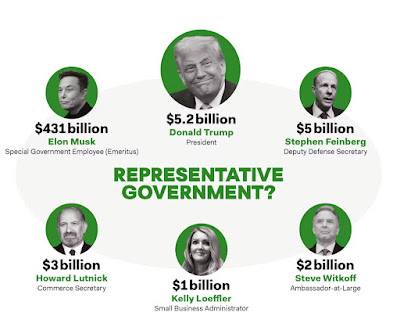How the Billionaires Took Over
The New Republic: “Yes, Donald Trump is a threat to democracy. But the far bigger menace is the monstrous growth in wealth concentration over five decades that made a Trump presidency possible—and maybe inevitable.
Here’s how we let it happen. Donald Trump is America’s first billionaire president. He entered the White House in 2017 with a net worth of $3.7 billion, according to Forbes, and in 2025 with a net worth of $5.2 billion. Trump’s habitat, unlike yours or mine, is crowded with billionaires.
His primary residence outside the White House is in Palm Beach, home to 68 billionaires, including the financiers Stephen Schwarzman and Ken Griffin, who—just those two—spent a combined $144.2 million to elect Trump and other Republicans in 2024.
For his second term, Trump brought eight fellow billionaires into his administration, including “special government employee” Elon Musk, who is the richest person in the world (net worth as of May 28: $431 billion); Commerce Secretary Howard Lutnick ($3 billion); Education Secretary Linda McMahon ($3 billion); Deputy Defense Secretary Stephen Feinberg ($5 billion); Ambassador-at-Large Steve Witkoff ($2 billion); and Small Business Administration Administrator Kelly Loeffler ($1 billion). Jared Isaacman ($2 billion) was nominated for NASA administrator but later withdrawn.
Treasury Secretary Scott Bessent is often described in news accounts as a billionaire, but his declared net worth is only about half a billion, and Bessent’s name does not appear on billionaire lists compiled and updated meticulously by Forbes and Bloomberg. Add in two billionaire ambassadors, Arkansas banker Warren Stephens (U.K.) and Texas restaurant and casino tycoon Tilman Fertitta (Italy), and the combined wealth of the Trump Nine approaches $460 billion.
Trump talks about buying Greenland from Denmark, but if the billionaires in Trump’s administration pooled their resources, they’d have enough to buy Denmark itself (GDP $450 billion). Neither Greenland nor Denmark is for sale, of course, because countries aren’t bought and sold. But it’s characteristic for billionaires to presume that everything is for sale.
Including, now, the government of the United States. Which sort of is. In his farewell address, President Joe Biden warned that “an oligarchy is taking shape in America of extreme wealth, power, and influence that literally threatens our entire democracy, our basic rights and freedoms, and a fair shot for everyone to get ahead.” Biden was talking about his successor, Trump, and he was right. No previous president brought in anywhere near so many billionaires as Trump—not even Trump himself during his first term.
The combined wealth of Biden’s Cabinet was $118 million, so obviously his administration was no haven for billionaires. The combined wealth of President Barack Obama’s Cabinet spiked to $2.8 billion during his second term, thanks to the presence of its sole billionaire, Commerce Secretary Penny Pritzker. Even Trump’s first-term Cabinet had only one confirmed billionaire, Education Secretary Betsy DeVos.
But there were enough multi-millionaires like Commerce Secretary Wilbur Ross to boost the Cabinet’s combined wealth to $6.2 billion—a record at that time, but nowhere near the $445 billion net worth possessed today by Trump’s Cabinet. When you exclude Musk (whose Department of Government Efficiency isn’t really a department, and who announced in late May that he was done with Washington), Trump’s Cabinet is worth $14 billion, still more than twice the combined net worth of Trump’s first-term Cabinet…We’re in uncharted waters.
“It’s tempting to liken this to the Gilded Age,” Michael Waldman, president of the nonprofit Brennan Center for Justice and a former speechwriter for Bill Clinton, told Elisabeth Bumiller of The New York Times in January. “But John D. Rockefeller didn’t actually run McKinley’s campaign or move into the White House.”
…Waldman might have added that the Gilded Age never gave us a president who issued his own currency, as Trump has done no fewer than four times, or owned a majority stake in the private company (Truth Social) that informs the nation of his policies. At the end of Trump’s first term, the nonprofit Citizens for Responsibility and Ethics in Washington, or CREW, tallied nearly 4,000 financial conflicts of interest. These continue to proliferate in Trump’s second term. There are Trump Bibles (Trump doesn’t attend church), Trump wine tumblers (Trump doesn’t drink), Trump key chains, Trump hoodies, Trump wrapping paper, Trump umbrellas, Trump golf balls, Trump beach towels, Trump sneakers, and Trump pajamas, most of these available at www.trumpstore.com. The proceeds go not to some campaign fund but to the Trump Organization, a privately held corporation owned by the president and run by his two oldest sons. Everything’s for sale…”
